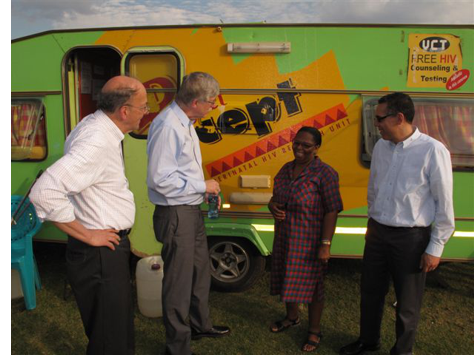A Phase III Randomized Controlled Trial of Community Mobilization, Mobile Testing, Same-Day Results, and Post-Test Support for HIV in Sub-Saharan Africa and Thailand
 NIMH Project Accept (HPTN 043) was the first community-randomized trial to test a combination of social, behavioral and structural interventions for HIV prevention and to assess the impact of an integrated strategy at the community level. The study was conducted in 34 communities in Africa (in South Africa, Tanzania, and Zimbabwe) and 14 communities in Thailand. The four major interventions of the study weredesigned to; 1) increase access to voluntary counseling and testing and post-test services; 2) change community attitudes around HIV awareness, particularly the benefit of knowing one's HIV status; 3) remove barriers to knowing one's HIV status; and 4) increase the safety of testing and minimize the potential negative consequences of testing by providing various forms of support.
NIMH Project Accept (HPTN 043) was the first community-randomized trial to test a combination of social, behavioral and structural interventions for HIV prevention and to assess the impact of an integrated strategy at the community level. The study was conducted in 34 communities in Africa (in South Africa, Tanzania, and Zimbabwe) and 14 communities in Thailand. The four major interventions of the study weredesigned to; 1) increase access to voluntary counseling and testing and post-test services; 2) change community attitudes around HIV awareness, particularly the benefit of knowing one's HIV status; 3) remove barriers to knowing one's HIV status; and 4) increase the safety of testing and minimize the potential negative consequences of testing by providing various forms of support.
NIMH Project Accept was funded as a National Institute of Mental Health (NIMH) Cooperative Agreement involving the NIMH and several U.S. and international institutions. The HIV Prevention Trials Network (HPTN) also provides support to the project (HPTN 043); support was also been provided by the Office of AIDS Research of the National Institutes of Health.
Visit the NIMH Project Accept website to learn more about the study, the sites where was implemented, and the members of the study teams at each site. The study protocol and other documents are also available on the study website.
Questions about NIMH Project Accept/HPTN 043 should be directed to:
Greg Szekeres
UCLA David Geffen School of Medicine
Division of Infectious Diseases
10940 Wilshire Boulevard
Suite 1220, Box 957320
Los Angeles, CA 90024-3916
U.S.A.
Phone: 310-794-3579
Fax: 310-794-2795
Email: gszekeres@mednet.ucla.edu
Study Details
To assess the efficacy of a comprehensive community-based HIV-1 voluntary counseling, testing (CBVCT), and support service intervention in reducing population-level HIV-1 incidence.
Phase III community-level randomized trial in which communities will be randomized to one of two arms, intervention (community-based voluntary counseling and testing (CBVCT) for HIV) or control (standard, clinic-based VCT). The assessment of efficacy is based on changes in communities using repeat cross sectional data collected from a representative community sample of 18 to 32 year old individuals at baseline and at the end of the intervention period. The first survey will involve only behavioral data, while the second survey will involve both behavioral data and HIV prevalence, and assays to determine prevalence of recent infection (the primary study endpoint).
This intervention is designed for the general population in HPTN priority developing countries where the population-level incidence of HIV is greater than 3% annually, and community-level prevalence is no less than 5%.
The study will be implemented in approximately 48 matched pairs of communities, distributed across five sites in four countries (South Africa, Tanzania, Zimbabwe and Thailand). A total of 34 communities will be involved in the African sites, and 14 communities will be involved in the Thai site. The pre-intervention behavioral survey will target recruitment of 13,000 individuals. The intervention phase of the study is expected to include at least 146,000 individuals in both study groups. The recruitment target for the post-intervention biological assessment is 50,320. The post-intervention behavioral assessment will involve the same number of particpants as the pre-intervention survey.
The intervention component of the study will last 3 years. The entire study project, from planning work through data analysis, is scheduled to last 8 years.
A key goal of this intervention approach is to stimulate behavioral risk reduction and declines in HIV incidence throughout communities. Therefore, the experimental intervention proposes to incorporate several enhancements to standard clinic-based VCT, including community mobilization, community based (mobile) VCT, and post-test support services.
To test the hypothesis that communities receiving 3 years of CBVCT, relative to communities receiving 3 years of SVCT, will have significantly lower prevalence of recent HIV infection.
To test the hypothesis that CBVCT communities, relative to SVCT communities, will at the end of the intervention period report significantly: less HIV risk behavior, higher rates of HIV testing, more favorable social norms regarding HIV testing, more frequent discussions about HIV, more frequent disclosure of HIV status, less HIV-related stigma, and fewer HIV-related life events.
A third aim is to assess the incremental cost-effectiveness of CBVCT compared to SVCT in terms of cost per HIV infection averted and disability adjusted life years saved.

